Osteopetrosis or Marble Bone Disease– This is an extremely rare genetic disorder of the bones in which the bones get harder and denser; this condition in turn leads to bones getting dissolved and ultimately break.

What Is Osteopetrosis Or Marble Bone Disease?
Osteopetrosis is a medical condition in which the osteoclasts present in the body whose function to resorb the bone fail to do so causing impairment of the process of bone modeling and remodeling. This ultimately causes a fragile skeletal system in spite of the fact that there is increased bone mass. This condition may also cause bone marrow failure, nerve entrapment syndromes, and severe growth impairment.
There Are Two Main Forms Of Osteopetrosis:
- Recessively Inherited Severe Osteopetrosis
- Dominantly Inherited Mild Osteopetrosis
What Are The Causes Of Osteopetrosis Or Marble Bone Disease?
Normal bone growth takes place when there is a balance between bone formation which is done by osteoblasts and bone resorption which is done by osteoclasts. In cases of osteopetrosis, the osteoclasts are unable to function adequately which affects resorption of bones. Why osteoclasts malfunction is not clear but studies point to a deficiency of carbonic anhydrase in osteoclasts. As a result of reduced bone resorption, excess bones are formed.
What Are The Symptoms Of Osteopetrosis Or Marble Bone Disease?
Symptoms For Severe Forms Of Osteopetrosis Are:
- Short stature infant with large head and frontal bossing
- Presence of blindness and deafness
- Anemia
- Hydrocephalus.
In Cases Of Mild Form Of Osteopetrosis
- There may be presence of osteoarthritis or osteomyelitis
- In rare instances, there may be nerve compression along with deafness or blindness.
How Is Osteopetrosis Or Marble Bone Disease Diagnosed?
A diagnosis of Osteopetrosis is usually made by x-rays which normally confirms the diagnosis. In this, the bones may appear club like. There will be thickened and dense skull base. The sinuses may appear small.
CT scans may also be required in some cases. MRI scans are required when there is bone marrow involvement which is a potentially serious condition and requires bone marrow transplantation.
In severe cases of Osteopetrosis, there are reduced levels of plasma calcium and elevation in the levels of acid phosphatase and calcitriol.
What Are Treatments For Osteopetrosis Or Marble Bone Disease?
In cases of Osteopetrosis in adults, there are no treatments required; however in cases of children affected with Osteopetrosis treatment involves treating complications and improving quality of life.
Some Ways To Manage Infantile Osteopetrosis Are:
- Adequate intake of Vitamin D
- Use of high doses of Calcitriol
- Use of gamma interferon
- Erythropoietin for correcting anemia
- Corticosteroids can also be used to treat anemia and facilitate bone resorption
- Bone marrow transplantation in cases of bone marrow involvement
- Surgical treatment for correction of fractures.
- Stark Z, Savarirayan R. Osteopetrosis. Orphanet J Rare Dis. 2009;4:5. doi: 10.1186/1750-1172-4-5. (https://pubmed.ncbi.nlm.nih.gov/19216777/)
- Bollerslev J, Henriksen K, Nielsen MF, Brixen K, Van Hul W. Autosomal dominant osteopetrosis revisited: lessons from recent studies. Eur J Endocrinol. 2013;169(2):R39-R57. doi: 10.1530/EJE-13-0160. (https://pubmed.ncbi.nlm.nih.gov/23616729/)
- Frattini A, Pangrazio A, Susani L, et al. Chloride channel ClCN7 mutations are responsible for severe recessive, dominant, and intermediate osteopetrosis. J Bone Miner Res. 2003;18(10):1740-1747. doi: 10.1359/jbmr.2003.18.10.1740. (https://pubmed.ncbi.nlm.nih.gov/14584887/)
- Whyte MP, Obrecht SE, Finnegan PM, Jones JL, Podgornik MN, McAlister WH. Osteopetrosis and infantile neuroaxonal dystrophy: a single autosomal recessive disorder? J Bone Miner Res. 1996;11(11):1430-1443. doi: 10.1002/jbmr.5650111008. (https://pubmed.ncbi.nlm.nih.gov/8914525/)
- Frattini A, Orchard PJ, Sobacchi C, et al. Defects in TCIRG1 subunit of the vacuolar proton pump are responsible for a subset of human autosomal recessive osteopetrosis. Nat Genet. 2000;25(3):343-346. doi: 10.1038/77131. (https://pubmed.ncbi.nlm.nih.gov/10888888/)
